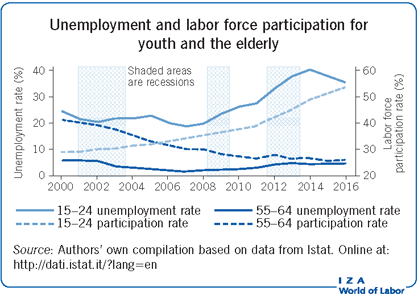Elevator pitch
The Italian labor market suffered a sizable negative shock from the double-dip recession and has since experienced a moderate recovery beginning in 2014. Despite some improvement, unemployment remains higher than pre-crisis levels, especially for young workers. Female participation has been slowly increasing. Regional heterogeneity is still high, with the stagnating south unable to catch up with the north. Real earnings have been increasing, but productivity is stable at relatively low levels compared to other European countries. Finally, undeclared employment is high, especially in the south.

Key findings
Pros
After increasing significantly during the recent double-dip recession, both average and long-term unemployment began to decrease in 2014.
Job vacancies have increased since the large drop in 2009.
Female labor force participation is increasing, albeit slowly.
Older workers’ (aged 55–64) labor force participation has increased substantially in recent years.
Real earnings have increased, although they should be accompanied by proportional increases in productivity, which so far have not been seen.
Cons
Unemployment remains higher than pre-crisis levels.
Southern regions are lagging behind the rest of the country in all labor market aggregates, with no appreciable sign of convergence.
Female labor force participation is still low, especially in the south.
There has been a large increase in youth unemployment since the crisis, with only minor improvements seen since 2014.
The labor force participation of young individuals (aged 15–24) has decreased significantly since 2000.